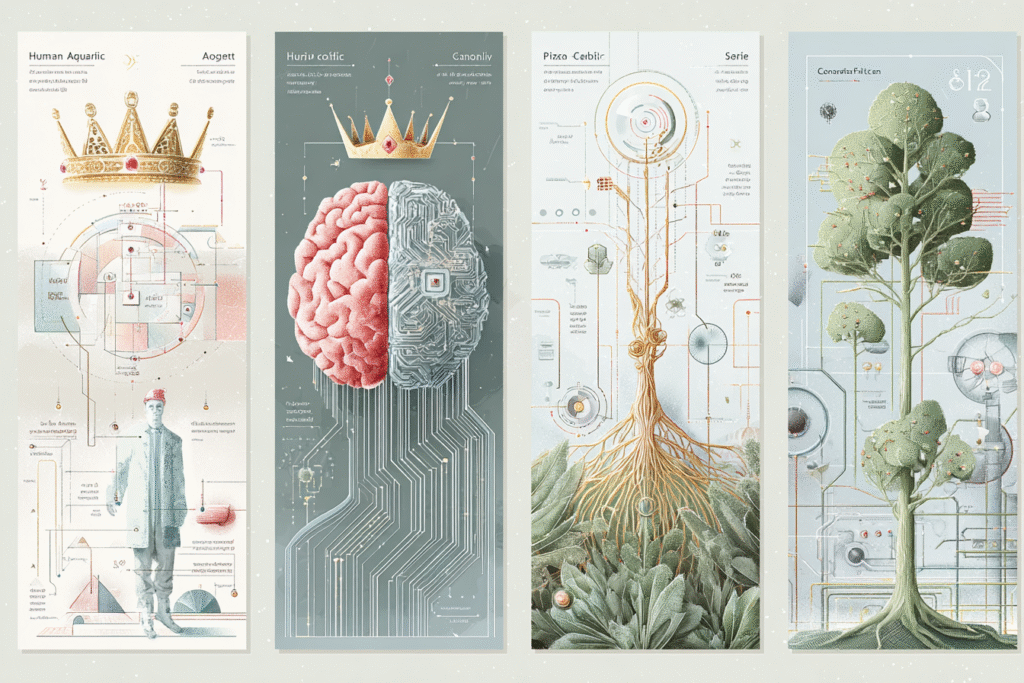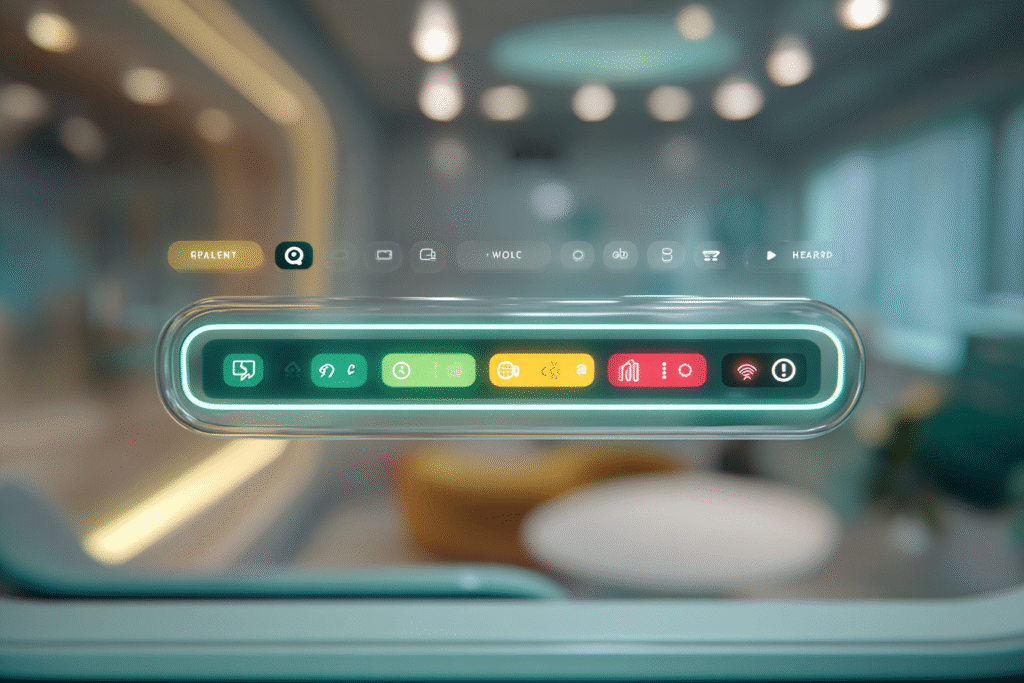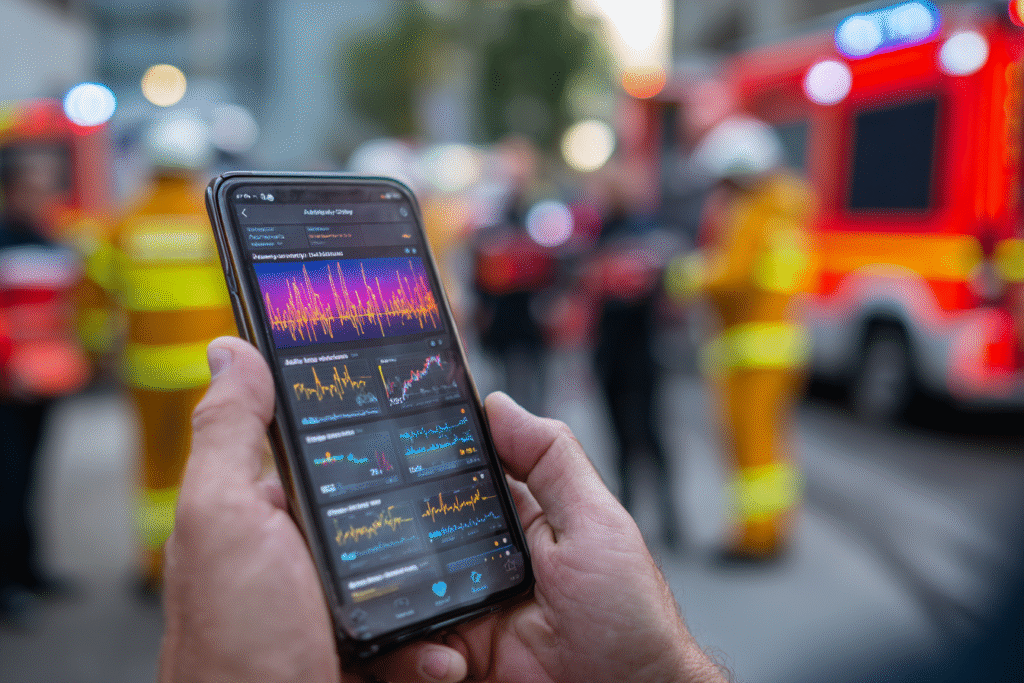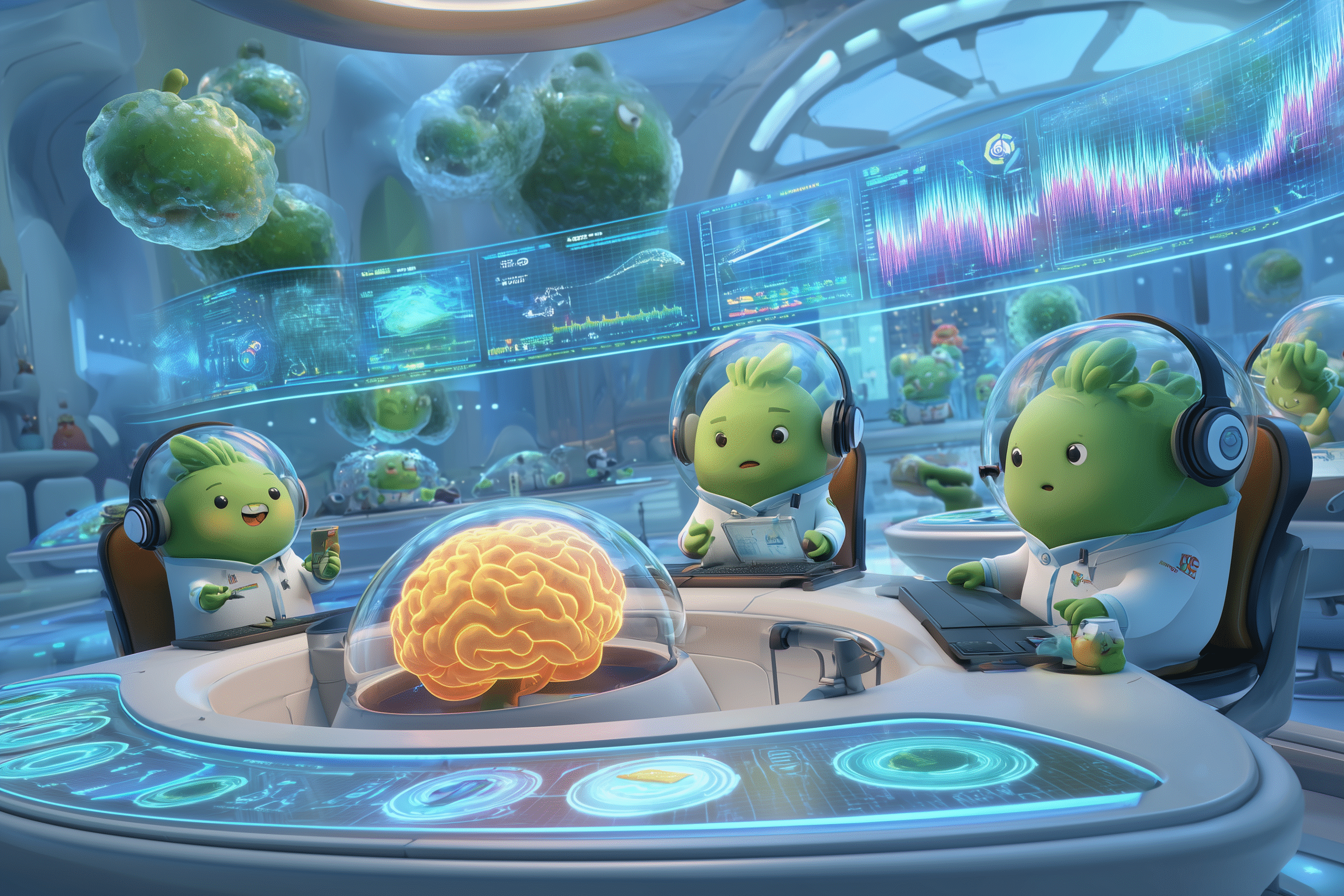Your health, your control. Intelligence, not replacement. Partnership, not dependence.
Note: This article is for educational and informational purposes only. See full disclaimer at the end.
The most important health decision of this decade isn’t about diet, movement, or supplements. It’s how to partner with artificial intelligence without surrendering your sovereignty.
Your smartphone can now detect irregular heart rhythms with clinical accuracy, analyze your speech patterns for early signs of cognitive decline, and predict potential health crises before symptoms appear. These capabilities have evolved rapidly, transforming our devices from simple communication tools into sophisticated health intelligence systems.
Yet most of us are approaching this revolution like passengers on a flight where we’re not sure who’s flying the plane.
We’re either completely hands-off, letting AI make increasingly complex health decisions for us, or we’re white-knuckling it, refusing to engage with tools that could genuinely save our lives.
Both approaches miss the profound opportunity before us: conscious partnership with AI that amplifies human intelligence rather than replacing human judgment.
This is the synthesis that the Health Transformation Arc has been building toward—not just how to use AI health tools, but how to partner with them while maintaining complete authority over your health decisions.

Rewriting the Rules of Health Collaboration
Human–AI collaboration in medical decision-making shows that endoscopists achieved better outcomes by treating AI as a knowledgeable colleague rather than either following it blindly or ignoring it completely [1]. They followed AI advice more when it was correct and maintained their independent judgment when it wasn’t—exactly the kind of nuanced partnership we need to master.
The false choice between “human vs. AI” in healthcare has dominated the conversation for far too long.
The human-centered AI (HCAI) approach emphasizes that effective healthcare AI should augment rather than replace human capabilities, ensuring humans remain at the center of medical decision-making [2]. This means AI becomes our intelligence amplifier, not our replacement.
The last few articles have equipped you with three foundational frameworks that, when integrated, create a comprehensive approach to conscious AI health partnership:
The AI Partnership Protocol (Day 50): Establishing human authority in AI relationships through Signal Integration, Pattern Recognition, Predictive Intervention, and Adaptive Learning.
Health Data Sovereignty (Day 53): Maintaining control over your health data, decisions, and the systems that influence them.
AI Health Cautions (Day 54): Protection protocols to avoid bias, hallucinations, and dependency while maximizing AI benefits.
These aren’t separate tools—they’re interlocking components of a single, powerful approach to conscious health partnership.
The Human-AI Health Partnership Framework
Today we’re synthesizing these elements into a unified system for navigating the AI health revolution while maintaining complete sovereignty over your health journey. This isn’t about learning to use another health app—it’s about fundamentally redefining your relationship with health intelligence.

Core Partnership Principles
Principle 1: Human Authority
You are the final decision-maker. AI advises, you decide.
You remain the senior partner in all health decisions. Physician autonomy in AI-supported healthcare requires maintaining decision-making authority, with AI providing recommendations that must be evaluated against human judgment and patient context [16]. AI provides information and insights; you provide context, values, and final decisions.
Principle 2: Intelligent Amplification
Together, human intuition and machine insight create superhuman clarity.
The goal is human + AI intelligence that exceeds what either could achieve alone. Effective human-AI collaboration creates hybrid intelligence where the combined system outperforms both humans and AI working independently [1]. Your intuition about your body combined with AI’s pattern recognition creates unprecedented health awareness.
Principle 3: Adaptive Partnership
The collaboration evolves as your needs, goals, and trust evolve.
The relationship evolves based on performance, trust, and changing health needs. Successful human-AI collaboration requires adaptability, allowing the AI system to adjust its recommendations based on user feedback and changing circumstances [5]. What works for preventive care may differ from acute situation management.
Principle 4: Transparent Collaboration
Clarity about AI’s capabilities empowers better, safer decisions.
Understanding AI limitations and capabilities prevents both over-reliance and under-utilization. Patient autonomy in AI-supported healthcare requires transparency about how AI systems make decisions and what their limitations are [17].
You can’t partner effectively with something you don’t understand.
Now that we’ve established these foundational principles, let’s translate them into a practical implementation system that builds partnership capability progressively.

The Partnership Integration Protocol
Phase 1: Conscious Foundation (Week 1)
Establish your health baseline and partnership parameters. Apply the AI Partnership Protocol’s Signal Integration phase to identify which AI tools align with your health goals and values. Use Health Data Sovereignty principles to control what data you share and with whom.
Begin with low-stakes AI interactions: symptom checkers for minor issues, activity tracking for fitness patterns, or sleep optimization suggestions. The goal is calibrating the partnership without life-critical decisions [3].
Phase 2: Intelligence Synthesis (Week 2)
Integrate AI insights with your body awareness and health knowledge. Apply Pattern Recognition from the AI Partnership Protocol while using AI Health Cautions to identify potential bias or limitations [8].
Example: Your wearable suggests you’re developing a respiratory issue based on heart rate variability and sleep disruption. Instead of ignoring it or panicking, you investigate: Has your stress been unusually high? Are you in allergy season? Does your personal health history support this concern? You use AI data as one input in a broader health assessment.
Phase 3: Predictive Partnership (Week 3)
Allow AI to provide early warning systems while maintaining interpretive authority. AI can identify patterns in health data that might escape human detection, but the clinical significance must be evaluated by healthcare professionals [9]. You’re partnering on prediction, not surrendering prediction to AI.
Phase 4: Adaptive Evolution (Ongoing)
Continuously calibrate the partnership based on outcomes and changing health needs. Your chronic condition management might involve deeper AI integration than your preventive care. Your partnership evolves as your health journey evolves.

Decision Authority Matrix
Not all health decisions are created equal. Your partnership with AI should reflect the stakes and complexity involved:
Green Zone (AI-Suggested, Human-Verified)
- Activity optimization recommendations
- Sleep hygiene suggestions
- Nutrition pattern insights
- Stress management techniques
AI can suggest, you verify against your experience and implement selectively.
Yellow Zone (AI-Informed, Human-Decided)
- Symptom assessment and next steps
- Preventive care scheduling
- Medication adherence optimization
- Health goal setting and tracking
AI provides comprehensive information, you make informed decisions with healthcare provider input when appropriate.
Red Zone (AI-Flagged, Human-Prioritized)
- Emergency health alerts
- Significant health changes
- Medical intervention decisions
- Chronic condition management adjustments
AI can flag concerns and provide information, but all decisions flow through your judgment and healthcare provider guidance.
Real-World Partnership Scenarios
Scenario 1: AI-Enhanced Appointment Preparation
AI can significantly enhance patient preparation for healthcare appointments by organizing symptoms, medical history, and relevant questions based on the patient’s health data [10]. Your AI health assistant analyzes your recent symptoms, sleep patterns, and activity levels before your doctor’s appointment.
The Partnership Approach: You review AI’s findings, add the human layer—stressors, life changes, subtle symptoms—and walk into the appointment informed, not overridden [11].
Your Authority: You decide what information to share, which AI insights seem relevant, and how to incorporate provider recommendations with AI suggestions [12].

Scenario 2: Chronic Condition Partnership
For diabetes management, your continuous glucose monitor’s AI suggests meal timing and exercise adjustments based on patterns it detects [13].
The Partnership Approach: You evaluate AI suggestions against your schedule, preferences, and how your body typically responds. You might accept the exercise timing recommendation but modify the meal suggestion based on your family dinner plans [14].
Your Authority: You remain in complete control—using AI’s suggestions as input, not instruction, to optimize outcomes within your lifestyle constraints [15].
Scenario 3: Preventive Care Optimization
Your health tracking shows patterns suggesting seasonal affective disorder risk based on activity, sleep, and location data.
The Partnership Approach: You investigate the pattern using both AI insights and self-reflection. Does this align with your personal experience? What interventions feel appropriate? You cross-reference the AI’s data points (sleep quality drops, activity decreases, mood tracking changes) with your own awareness of seasonal patterns from previous years.
You might use AI to optimize light therapy timing while rejecting medication suggestions.
Your Authority: You decide whether the pattern is meaningful, which interventions to try, and when to seek professional guidance.
Scenario 4: Emergency Response Partnership
Your wearable detects irregular heart rhythms and suggests immediate medical attention.
The Partnership Approach: You assess the urgency using both AI data and your physical sensations. Is this consistent with known conditions? Are you experiencing symptoms? The AI provides data; you provide context and make the decision about immediate response.
Your Authority: AI provides critical data about potential cardiac issues, but you evaluate the full context—your symptoms, medical history, current circumstances—to determine the appropriate level of medical response.

Building Long-Term Partnership Intelligence
Sustainable human-AI health partnership requires ongoing calibration and evolution. Successful human-AI collaboration in healthcare depends on developing appropriate trust calibrated to the specific context and stakes of each decision [4].
Partnership Calibration Signals
Green Flags: AI suggestions align with your experience and lead to positive outcomes. The system provides clear explanations for recommendations [17]. You feel more informed and empowered in health decisions.
Yellow Flags: AI suggestions sometimes conflict with your instincts or provider recommendations. The system occasionally provides confusing or contradictory information [18]. You’re unsure about the reasoning behind certain suggestions.
Red Flags: You’re consistently deferring to AI over your own judgment or provider guidance. The system is making decisions for you rather than with you [19]. You feel dependent on AI rather than empowered by it.
Continuous Partnership Evolution
Your relationship with AI health tools should mature as your health literacy and the technology improve. Early partnership focuses on basic pattern recognition and simple optimizations [20]. Advanced partnership might involve complex predictive modeling and sophisticated intervention strategies [21].
The key is maintaining conscious choice about depth and scope of AI integration. Patient autonomy in AI-enhanced healthcare requires maintaining the ability to understand, question, and override AI recommendations when human judgment or patient values dictate different choices [24].
The Conscious Health Future
You’re now equipped with a comprehensive framework for conscious AI health partnership. With this foundation laid, we can now shift focus towards “Nutrition & Food Intelligence”—where everything you’ve learned about AI partnership applies to one of the most data-rich, decision-dense areas of modern health.

Your AI partnership approach will prove invaluable as we explore:
- Personalized Nutrition AI: Using food tracking, metabolic response, and health goals to optimize eating patterns while maintaining food freedom and cultural preferences.
- Intelligent Meal Planning: Partnering with AI for nutrition optimization without losing the joy and social aspects of eating.
- Food Sensitivity Detection: Using AI pattern recognition to identify food-health connections while avoiding unnecessary restriction or food anxiety.
The partnership principles you’ve mastered—human authority, intelligent amplification, adaptive collaboration, and transparent decision-making—become your foundation for navigating nutrition AI without surrendering your relationship with food to algorithmic optimization.
Your Partnership Action Plan
Immediate Implementation (Next 7 Days)
Day 1-2: Partnership Assessment
Inventory your current AI health tools using the Decision Authority Matrix. Which tools are you using consciously versus automatically? Where might you be over-relying or under-utilizing AI insights?
Day 3-4: Authority Calibration
Practice the Partnership Integration Protocol with one low-stakes health decision. Use AI for information gathering, apply your judgment for decision-making, and evaluate the outcome.
Day 5-7: Framework Integration
Begin combining AI Partnership Protocol, Health Data Sovereignty, and AI Health Cautions into your daily health routine. Start small—perhaps optimizing sleep or activity patterns using AI insights while maintaining decision authority.
Week 2-4: Partnership Development
Gradually expand AI integration into more complex health decisions while maintaining strict adherence to your authority hierarchy. Practice explaining AI insights to healthcare providers and incorporating their feedback into your partnership approach.
Beyond Week 4: Mastery Integration
Your human-AI health partnership becomes a natural extension of your health intelligence. You’re comfortable leveraging AI for pattern recognition and prediction while maintaining complete sovereignty over health decisions. You understand AI limitations and capabilities well enough to maximize benefits while avoiding pitfalls.

The Partnership Promise
The future of healthcare lies in human-AI collaboration that enhances rather than replaces human judgment, creating better outcomes for patients while maintaining human agency in health decisions [6]. This isn’t about becoming cyborgs or surrendering to algorithms—it’s about conscious evolution of human health intelligence.
The AI health revolution is here whether we participate consciously or not [7]. The choice is between being shaped by these tools unconsciously or partnering with them deliberately to amplify our health intelligence while maintaining complete sovereignty over our health journey.
Your partnership with AI can provide pattern recognition you’d never achieve alone, prediction capabilities that could save your life, and optimization insights that enhance your quality of life—all while keeping you firmly in control of every health decision [22].
The future of health isn’t human versus AI. It’s human with AI, consciously directed, purposefully implemented, and continuously calibrated to serve your health goals while honoring your values, preferences, and autonomy [23].
Partnership, not dependence. Intelligence, not replacement. Your health, your control.
Welcome to the conscious health future. You’re now equipped not just to survive the AI health revolution, but to lead it.
See you in the next insight.
Comprehensive Medical Disclaimer: The insights, frameworks, and recommendations shared in this article are for educational and informational purposes only. They represent a synthesis of research, technology applications, and personal optimization strategies, not medical advice. Individual health needs vary significantly, and what works for one person may not be appropriate for another. Always consult with qualified healthcare professionals before making any significant changes to your lifestyle, nutrition, exercise routine, supplement regimen, or medical treatments. This content does not replace professional medical diagnosis, treatment, or care. If you have specific health concerns or conditions, seek guidance from licensed healthcare practitioners familiar with your individual circumstances.
References
To aid interpretation, references are annotated by source type. Academic sources form the core evidence base, while institutional and industry perspectives offer supplementary insights.
Reference Types
🔬 = Peer-reviewed / Academic
🏛️ = Government / Institutional
💼 = Industry / Blog
- 🔬 Reverberi, C., Rigon, T., Solari, A. et al. Experimental evidence of effective human–AI collaboration in medical decision-making. Scientific Reports 12, 14952 (2022). https://www.nature.com/articles/s41598-022-18751-2
- 🔬 Van der Laan, L.N., et al. Human centred explainable AI decision-making in healthcare. ScienceDirect (2025). https://www.sciencedirect.com/science/article/pii/S2666659625000046
- 🔬 Alowais, S.A., Alghamdi, S.S., Alsuhebany, N. et al. Revolutionizing healthcare: the role of artificial intelligence in clinical practice. BMC Medical Education 23, 689 (2023). https://bmcmededuc.biomedcentral.com/articles/10.1186/s12909-023-04698-z
- 🔬 Zhang, Y., Liao, Q. V. & Bellamy, R. K. Effect of confidence and explanation on accuracy and trust calibration in AI-assisted decision making. Proceedings of the 2020 Conference on Fairness, Accountability, and Transparency (2020). https://dl.acm.org/doi/10.1145/3351095.3372852
- 🔬 arXiv (2024). Evaluating Human-AI Collaboration: A Review and Methodological Framework. https://arxiv.org/html/2407.19098v1
- 💼 Infinitus (2025). Human-AI collaboration improves the healthcare patient experience. https://www.infinitus.ai/blog/human-ai-collaboration/
- 🏛️ World Economic Forum (2024). Human-AI-system partnership: Equitable healthcare’s trifecta. https://www.weforum.org/stories/2024/04/human-ai-system-collaboration-equitable-healthcare/
- 💼 xCube Labs (2024). Agentic AI in Healthcare: From Automation to Autonomy. https://www.xcubelabs.com/blog/agentic-ai-in-healthcare-from-automation-to-autonomy/
- 🔬 PMC (2024). The Role of AI in Hospitals and Clinics: Transforming Healthcare in the 21st Century. https://pmc.ncbi.nlm.nih.gov/articles/PMC11047988/
- 💼 KANINI (2024). Top 8 AI Use Cases in Healthcare for Driving Patient Engagement and Enhancing Patient Experience. https://kanini.com/blog/how-is-artificial-intelligence-ai-transforming-patient-engagement/
- 💼 Built In (2025). AI in Healthcare: Uses, Examples & Benefits. https://builtin.com/artificial-intelligence/artificial-intelligence-healthcare
- 💼 ScienceDirect (2023). Artificial intelligence for patient scheduling in the real-world health care setting: A metanarrative review. https://www.sciencedirect.com/science/article/abs/pii/S2211883723001004
- 🏛️ GOV.UK (2025). AI doctors’ assistant to speed up appointments a ‘gamechanger’. https://www.gov.uk/government/news/ai-doctors-assistant-to-speed-up-appointments-a-gamechanger
- 💼 Park University (2024). AI in Healthcare: Enhancing Patient Care and Diagnosis. https://www.park.edu/blog/ai-in-healthcare-enhancing-patient-care-and-diagnosis/
- 💼 Simbo AI (2024). The Growing Importance of Online Appointment Scheduling in Enhancing Patient Satisfaction and Experience. https://www.simbo.ai/blog/the-growing-importance-of-online-appointment-scheduling-in-enhancing-patient-satisfaction-and-experience-2963882/
- 🔬 Funer, F. & Wiesing, U. Physician’s autonomy in the face of AI support: walking the ethical tightrope. Frontiers in Medicine (2024). https://www.frontiersin.org/journals/medicine/articles/10.3389/fmed.2024.1324963/full
- 🔬 SpringerLink (2023). The Autonomous AI Physician: Medical Ethics and Legal Liability. https://link.springer.com/chapter/10.1007/978-3-031-41264-6_11
- 🔬 PMC (2024). Ethical and regulatory challenges of AI technologies in healthcare: A narrative review. https://pmc.ncbi.nlm.nih.gov/articles/PMC10879008/
- 🔬 AMA Journal of Ethics (2018). Should Artificial Intelligence Augment Medical Decision Making? The Case for an Autonomy Algorithm. https://journalofethics.ama-assn.org/article/should-artificial-intelligence-augment-medical-decision-making-case-autonomy-algorithm/2018-09
- 🔬 AI & Society (2024). Using artificial intelligence to enhance patient autonomy in healthcare decision-making. https://link.springer.com/article/10.1007/s00146-024-01956-6
- 🔬 PMC (2024). Editorial: Healthcare in the age of sapient machines: physician decision-making autonomy faced with artificial intelligence. https://pmc.ncbi.nlm.nih.gov/articles/PMC11391421/
- 🔬 The Lancet Digital Health (2020). Approaching autonomy in medical artificial intelligence. https://www.thelancet.com/journals/landig/article/PIIS2589-7500(20)30187-4/fulltext
- 🔬 AI and Ethics (2024). Preserving physician ethics in the era of autonomous AI. https://link.springer.com/article/10.1007/s43681-024-00602-7
- 🔬 BMC Medical Informatics and Decision Making (2023). The impact of artificial intelligence on the person-centred, doctor-patient relationship: some problems and solutions. https://bmcmedinformdecismak.biomedcentral.com/articles/10.1186/s12911-023-02162-y


